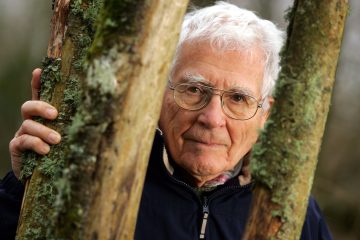Table of Contents
- Exploring the Gaia Hypothesis and Its Impact on Environmental Science
- James Lovelocks Pioneering Work in Climate Change Awareness
- Innovative Technology: Lovelocks Contributions to Sustainable Solutions
- Legacy of Advocacy: Lovelocks Role in Shaping Ecological Discourse
- The Future of Planetary Health: Lessons from James Lovelocks Vision
- Q&A
- Concluding Remarks
Exploring the Gaia Hypothesis and Its Impact on Environmental Science
The Gaia Hypothesis, proposed by James Lovelock in the 1970s, centers on the idea that Earth functions as a self-regulating, complex system. This perspective shifts how we understand the interactions between living organisms and their inorganic surroundings. By viewing the planet as a single entity, the hypothesis emphasizes the interconnectedness of life and the environment, highlighting that human actions can reverberate throughout the entire system. This paradigm has encouraged a holistic approach to environmental science, driving research into how ecosystems respond to changes in climate, biodiversity, and pollution.
One significant impact of the Gaia Hypothesis on environmental science is its influence on climate change discussions. The notion that Earth’s systems can self-regulate has sparked debates about the resilience and adaptability of environmental processes. This theory posits that the biosphere actively maintains conditions necessary for life, leading scientists to explore how disruptions—such as excessive carbon emissions—affect this balance. The hypothesis has prompted key studies in various fields, including ecology, climatology, and even economics, as researchers attempt to measure the ramifications of human activities in the context of the Earth as a living system.
Furthermore, the Gaia Hypothesis encourages a shift in policy-making and conservation efforts. By framing the planet’s health as essential to humanity’s survival, it advocates for sustainable practices that recognize the intrinsic value of nature. Initiatives from around the globe have been inspired by this perspective, leading to the development of practices such as permaculture, biodiversity conservation, and renewable energy solutions. The hypothesis serves not only as a theoretical framework but also as a call to action for governments, organizations, and individuals to adopt a more integrated approach to environmental stewardship.

James Lovelocks Pioneering Work in Climate Change Awareness
Among his many contributions to environmental science, James Lovelock is especially renowned for developing the Gaia Theory, which proposes that Earth’s biological and physical components form a self-regulating system. This groundbreaking perspective not only reshapes our understanding of Earth’s ecosystems but also emphasizes the interconnectedness of life. Through the lens of Gaia, Lovelock encourages us to view the planet not merely as a collection of resources, but as a complex and dynamic organism that requires careful stewardship.
His innovative approach brought climate change discussions to the forefront, long before they became mainstream concerns. By advocating for the idea that human activities are affecting the Earth’s systems, Lovelock initiated crucial debates about sustainability and conservation. His assertions have been instrumental in elevating climate awareness and pushing for legislative changes globally. His tireless work has led various organizations and governments to rethink their environmental policies, fundamentally impacting how society grapples with climate issues.
The following table highlights key milestones in Lovelock’s career that have significantly contributed to climate change awareness:
| Year | Milestone |
|---|---|
| 1965 | Introduction of the Gaia Theory |
| 1972 | Publication of “Gaia: A New Look at Life on Earth” |
| 2006 | Release of “The Revenge of Gaia” |
| 2020 | Continues to speak on climate change and environmental policy |
Through his thought-provoking theories and ongoing advocacy, Lovelock has undeniably shaped the narrative around climate change awareness, inspiring countless individuals and organizations to take action in the face of ecological challenges. His legacy serves as a crucial reminder that our planet’s health is intertwined with our actions, and the urgency to engage in sustainable practices has never been more critical.

Innovative Technology: Lovelocks Contributions to Sustainable Solutions
James Lovelock, an esteemed scientist and environmentalist, has made significant strides in the realm of sustainable solutions through his innovative technology. His Gaia theory posits that Earth functions as a self-regulating system, underscoring the intricate balance between living organisms and their environment. This paradigm shift in understanding nature has influenced diverse fields, from climate science to ecology, by promoting technologies that align human activity with ecological balance. Lovelock’s work emphasizes the need for renewable energy sources, leading to breakthroughs that integrate natural ecosystems into technological development.
Among his pioneering contributions, Lovelock introduced the concept of the Earth as a living organism, advocating for the development of technologies that respect and enhance our planet’s health. His insights have paved the way for sustainable agriculture practices, water conservation techniques, and waste management systems that reduce environmental impact. Key innovations include:
- Climate-Responsive Energy Systems – Developed technologies that harness renewable resources.
- Bioremediation Processes – Used microorganisms to decontaminate polluted environments.
- Advanced Recycling Technologies – Focused on waste-to-resource systems that minimize landfill reliance.
Furthermore, Lovelock’s advocacy for the use of artificial intelligence in ecological monitoring is transforming the way we understand and respond to environmental challenges. By utilizing advanced analytics and machine learning, we can predict ecological changes, assess climate impacts, and enhance resource management. An illustration of this can be seen in the application of smart sensors in urban settings, which monitor air quality and optimize energy usage. Here’s a brief look at some technologies inspired by Lovelock’s vision:
| Technology | Purpose | Impact |
|---|---|---|
| Solar Energy Systems | Convert sunlight into electricity | Reduces reliance on fossil fuels |
| Green Roof Technology | Enhances urban biodiversity | Improves insulation and reduces heat |
| Smart Water Management | Optimizes water usage | Minimizes waste in agricultural practices |

Legacy of Advocacy: Lovelocks Role in Shaping Ecological Discourse
James Lovelock’s legacy as an advocate for ecological awareness is intricately woven into the fabric of modern environmental discourse. He is renowned for proposing the Gaia Theory, which posits that the Earth functions as a self-regulating system, with living organisms and their inorganic surroundings interconnected. This revolutionary idea has sparked significant dialogues regarding the interdependence of life and the environment, urging humanity to adopt a more holistic approach to ecological issues.
As a dedicated scientist and passionate environmentalist, Lovelock’s contributions have highlighted the urgency of addressing climate change and biodiversity loss. Through a series of influential works, he has illuminated the symbiotic relationship between technology and nature, advocating for sustainable development. His perspectives encourage individuals and policymakers alike to consider the long-term implications of human activity on the planet. Some key components of his advocacy include:
- Emphasis on climate action: Urging immediate responses to climate-related challenges.
- Interconnectedness of life: Promoting the understanding of ecosystems as collaborative networks.
- Technology’s role: Exploring the potential of technology to mitigate ecological impact.
Moreover, Lovelock’s dedication to fostering a deeper understanding of ecological principles has inspired countless individuals and organizations. His thought-provoking ideas have not only shaped academic discussions but also informed public policy debates, leading to a profound shift in how we perceive our responsibilities toward the environment. The impact of his work is reflected in various initiatives aimed at promoting sustainability and ecological balance. A simple comparison in the table below illustrates the evolution of ecological thought before and after Lovelock’s contributions.
| Pre-Lovelock Era | Post-Lovelock Era |
|---|---|
| Disconnection between humans and nature | Critical interdependence acknowledged |
| Focus on single-species conservation | Integrated ecosystem preservation |
| Reactive environmental policies | Proactive, preventative strategies advocated |

The Future of Planetary Health: Lessons from James Lovelocks Vision
James Lovelock, a visionary scientist, has long advocated for a holistic understanding of our planet’s ecosystems. His Gaia theory posits that Earth operates as a single, self-regulating entity, where biological and physical components are interconnected, constantly interacting to maintain conditions favorable for life. This perspective is particularly prescient in today’s context, emphasizing the need for integrated approaches to environmental science and policy. By acknowledging the intricate relationships within ecosystems, we can better understand the impact of human actions on planetary health.
To embody Lovelock’s lessons, we must embrace sustainable practices that harmonize human existence with natural laws. Some key principles that emerge from his philosophy include:
- Interconnectedness: Recognizing that every action has a ripple effect throughout the environment.
- Adaptation: Embracing change as a constant and developing resilience strategies in response to environmental shifts.
- Proactive Stewardship: Prioritizing preventative measures over reactive solutions to foster long-term ecological health.
To take actionable steps towards a healthier planet, society needs to foster innovation while remaining rooted in ecological wisdom. Collaborative efforts across disciplines—merging science, technology, and community engagement—will pave the way for breakthroughs in understanding and mitigating environmental issues. Implementing effective policy changes and encouraging grassroots movements can transform Lovelock’s mid-20th-century vision into present-day realities. In this way, we not only honor his contributions but also ensure a thriving planet for future generations.
Q&A
Q&A: James Lovelock – A Visionary Mind of Environmental Science
Q1: Who is James Lovelock, and what is he best known for? A1: James Lovelock is a British scientist, environmentalist, and futurist, widely recognized for formulating the Gaia Theory. This revolutionary hypothesis views Earth as a self-regulating system where the biological and physical components work in harmony to sustain life. Lovelock’s insights have significantly influenced environmental science and ecological thinking.Q2: What is the Gaia Theory, and how has it impacted our understanding of the environment? A2: The Gaia Theory posits that the Earth and its biological systems behave as a single, self-regulating entity. This perspective emphasizes the interconnectedness of organisms and their environments, suggesting that life plays a vital role in maintaining the conditions necessary for its own existence. Lovelock’s work has reshaped how scientists and the public view ecological balance, prompting greater awareness of climate change and environmental protection.
Q3: Besides Gaia Theory, what other contributions has Lovelock made to science? A3: Beyond the Gaia Theory, Lovelock has made significant contributions in various fields. He invented the electron capture detector, which revolutionized the detection of pollutants in the environment. Lovelock has also worked on bioengineering and has authored numerous books and scientific papers, blending science with accessible narratives to engage a broader audience.
Q4: How did James Lovelock’s background and early experiences influence his work? A4: Lovelock’s background in chemistry and his early career as a scientist for NASA deeply shaped his interdisciplinary approach. His unique combination of scientific inquiry and environmental advocacy stems from his experiences working in various fields, including atmospheric science, which provided critical insights into the relationship between technology and nature.
Q5: What is Lovelock’s stance on climate change, and how does it reflect his scientific beliefs? A5: Lovelock has been vocal about climate change, often warning that humanity must take immediate action to mitigate its impacts. His belief is rooted in the notion that Earth’s systems are delicate and that ignoring the signs of climate disruption could lead to catastrophic consequences. He advocates for a shift toward renewable energy and sustainable practices, viewing these as essential to preserving planetary health.
Q6: What legacy is James Lovelock leaving behind? A6: James Lovelock’s legacy is one of pioneering thought and action in ecology and environmentalism. By challenging conventional views and advocating for a holistic understanding of nature, he has inspired generations of scientists, activists, and policymakers to consider the planet’s health as integral to our survival. His work continues to spur discussions on sustainability and climate resilience, affirming that individual and collective actions are crucial for our future.
Q7: Where can one learn more about James Lovelock and his works? A7: To dive deeper into James Lovelock’s ideas, one can explore his published books, such as “Gaia: A New Look at Life on Earth” and “The Revenge of Gaia.” Numerous documentaries and interviews are also available online, providing insight into his thoughts and the relevance of his work in today’s environmental debates.—This Q&A captures the essence of James Lovelock’s contributions, making it a valuable resource for anyone interested in understanding his lasting impact on environmental science.



0 Comments